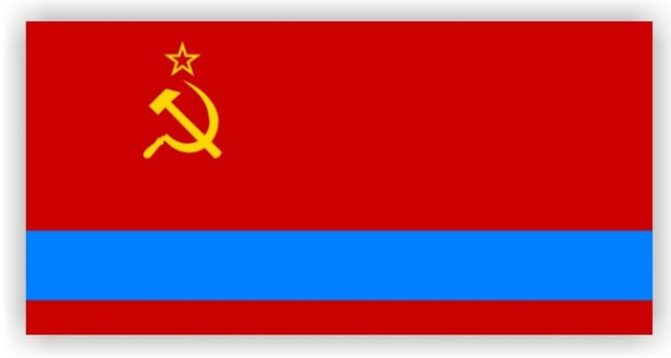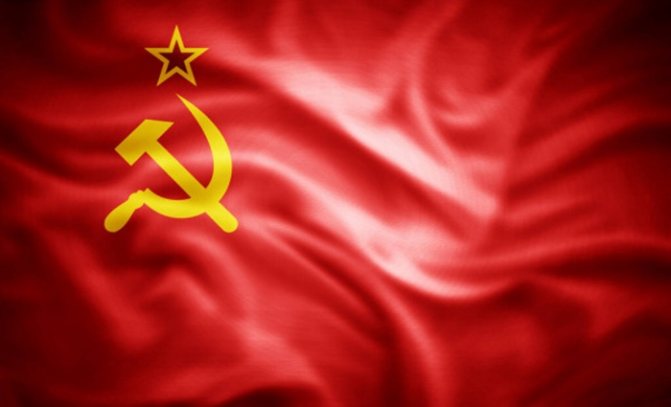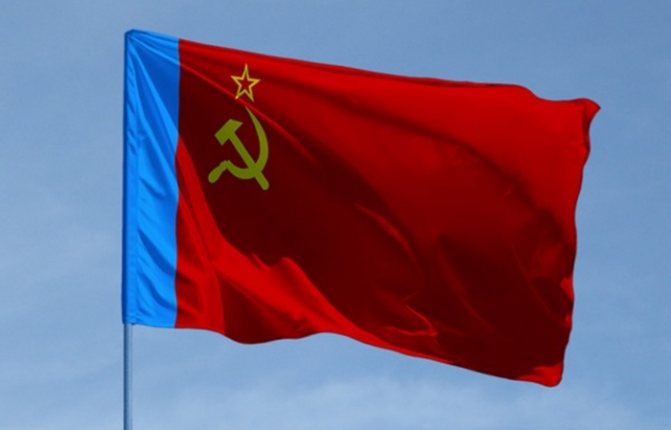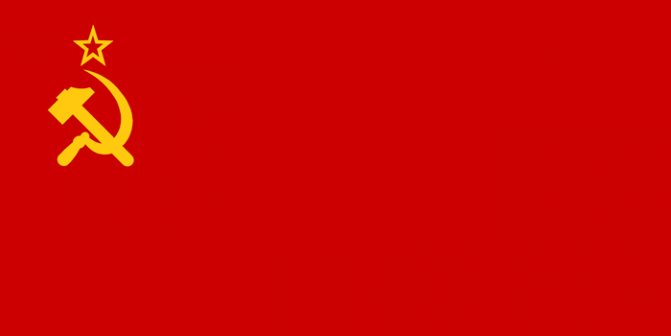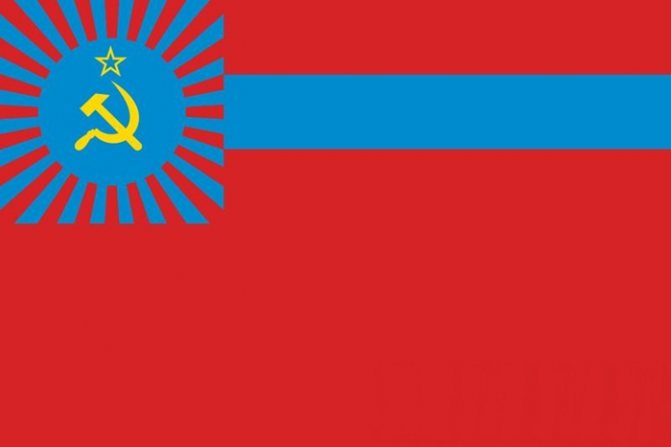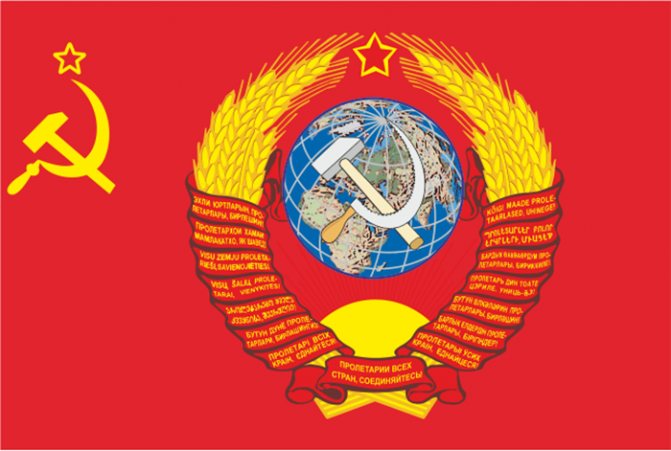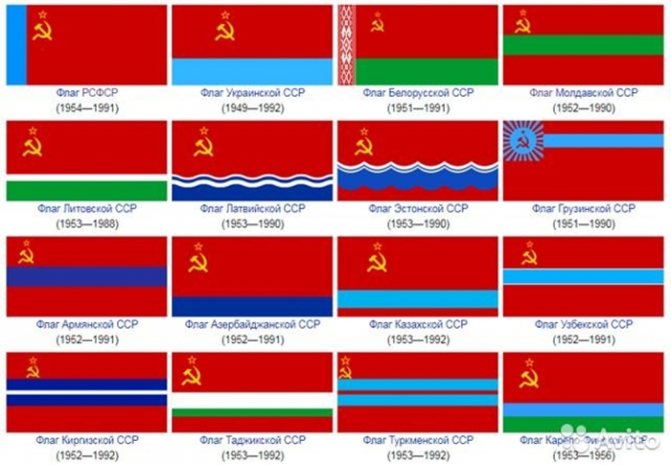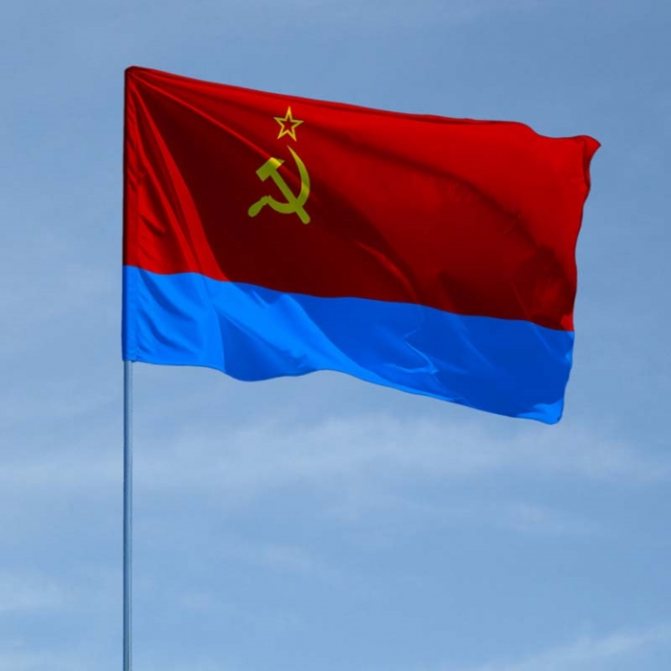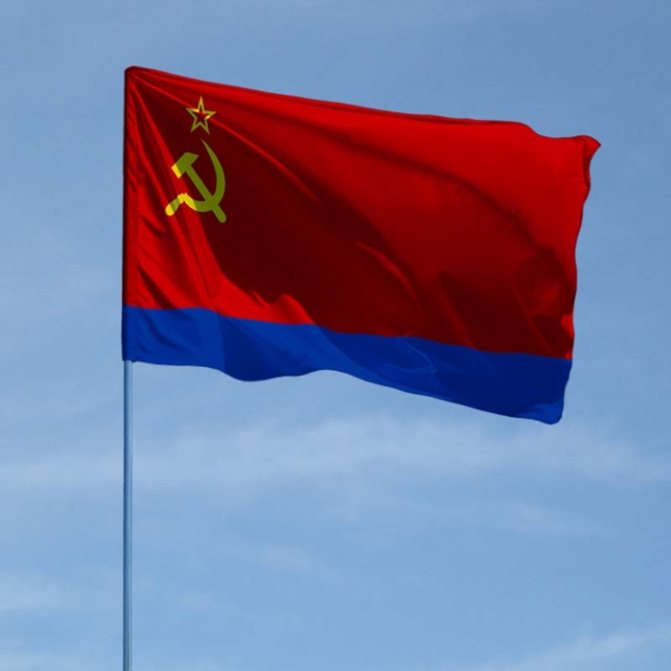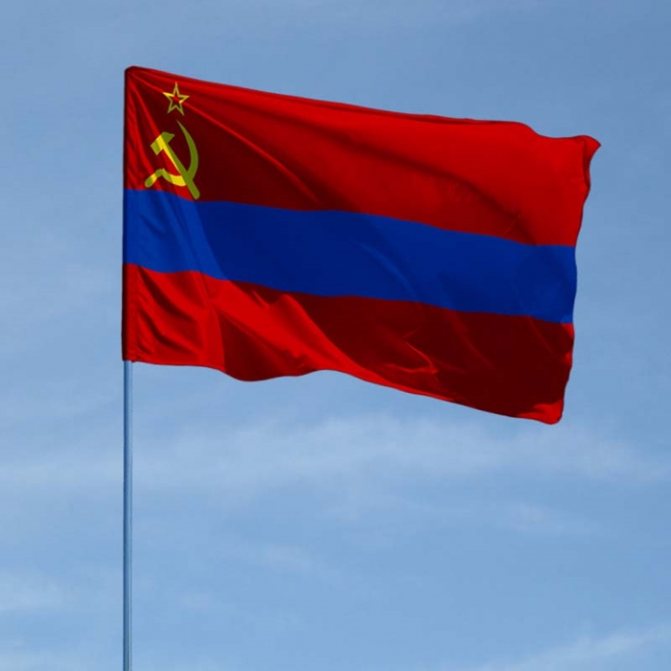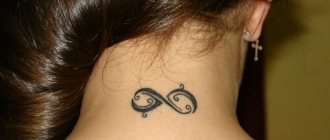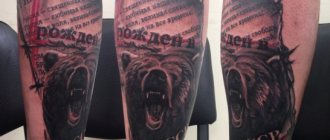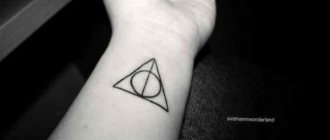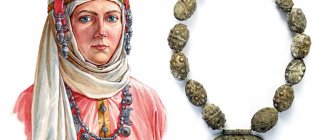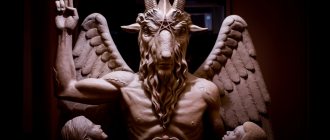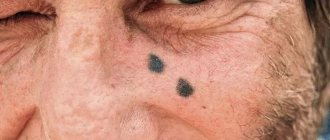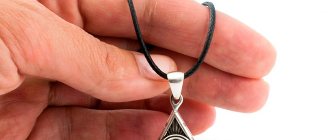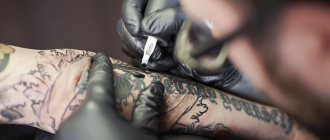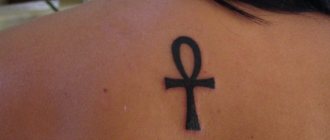Many people, pining for the former greatness of the country, choose a tattoo with the USSR quality sign and other symbols of the Soviet era. This is inherent not only in the representatives of mature age, but also in young people.
Such tattoos are not only an inscription with an abbreviation, but also symbolic for those times images and symbols. Distinctive features of such compositions are primitivism and the use of a small number of shades, usually not more than three (for example: red, black and brown).
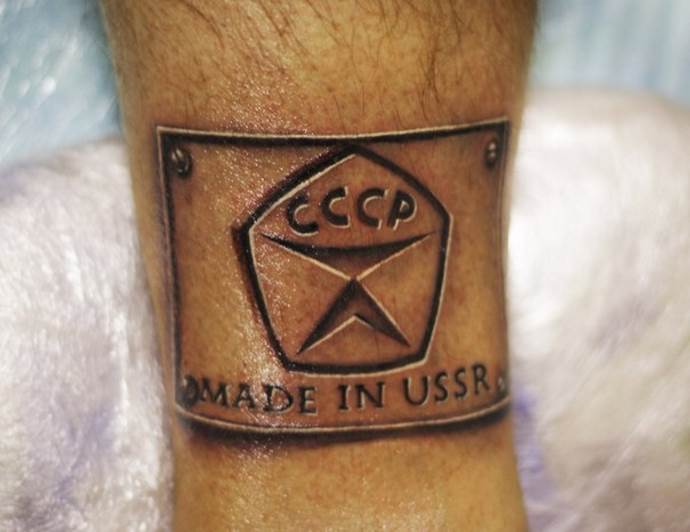
On the chest is a profile of Stalin.
The tale of portraits of Lenin and Stalin in Soviet prisons was told to newcomers. Some actually believed that the guards would not shoot at the leaders. Such tattoos were often found on prisoners ready to "go to the green prosecutor. In other words, ready to escape. The faces of the chiefs performed a similar role - protecting them from the bullets of the search teams. It was enough for a prisoner to tear the shirt on his chest to make the armed guards hesitate.
It is impossible to control the distribution of tattoos in prison. Convicts tattooed their own images or came with portraits that had been tattooed while they were still on the outside. All the Soviet prisoners had to do was to educate the new guards. The main thing in such a situation is not to get lost.
The sign of quality in tattoo culture
Now it is believed that all goods produced in the USSR are of the highest quality. This opinion is largely due to the fact that Soviet goods last much longer than modern products (although the latter favorably differ in design).
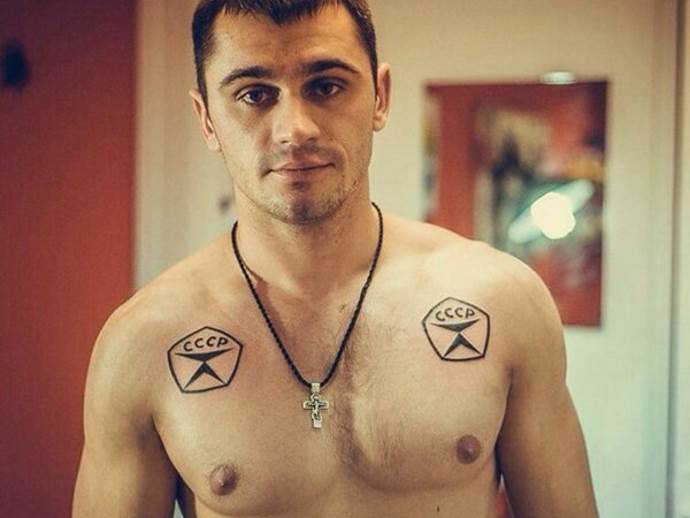

Not surprisingly, ambitious people often opt for this symbol when getting a tattoo. This is how they try to emphasize their superiority over others and prove to everyone that they are worthy of the heights to which they aspire. In addition, the tattoo is an indicator of age. It's stuffed Millennials, born under the Soviet system, but who met the dawn of the digital age in their youth, or seniors. Those born in the 2000s and later choose other tattoos not marked by nostalgia for the Soviet era.
For a long time a tattoo with a quality sign was considered prison, but now, like many other features of this subculture, it is not always unequivocally correlated to the source medium.
See about the choice of tattoo
Tattoo and the underworld
Surprisingly, the Stalin tattoo was very popular among prisoners during his reign. It is worth noting that the meaning of that tattoo differed significantly from the modern interpretation.
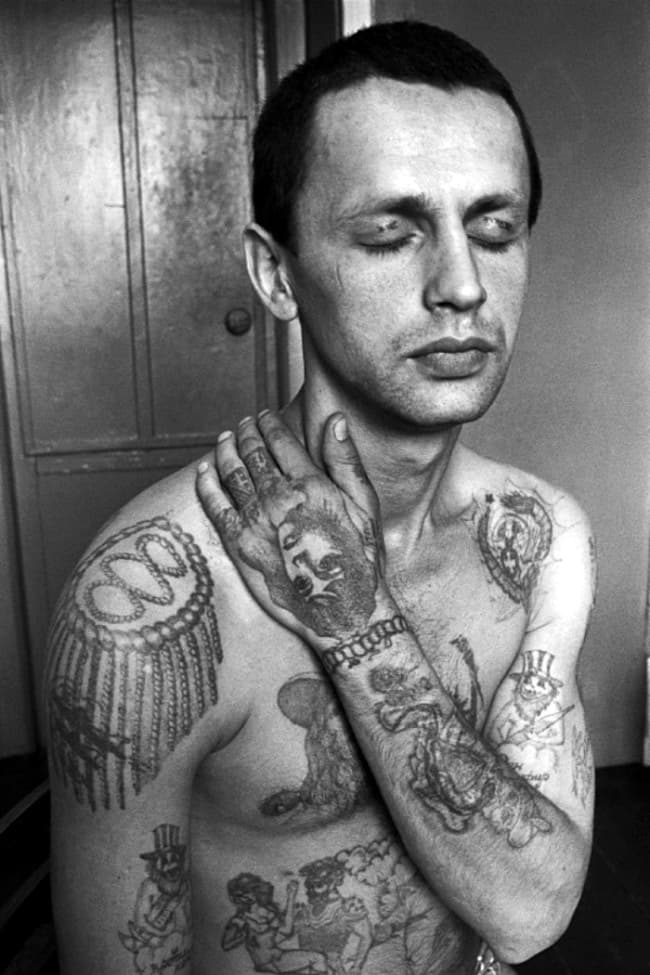

There were a total of two main reasons why prisoners tattooed Stalin on their chests. These reasons were the planned escape and the desire to avoid a firing squad. The whole point was that the guards might be afraid to shoot a prisoner with a portrait of the leader on his body, even if that prisoner attempted to escape. As for the second reason, the capital punishment of a firing squad was carried out by a shot to the chest. And since now the Chief was wearing his chest, the execution could be replaced by a long term of imprisonment.
Thus we see that the two different reasons were united by the desire to survive. It was this desire that forced the prisoners to make such tattoos on their bodies.
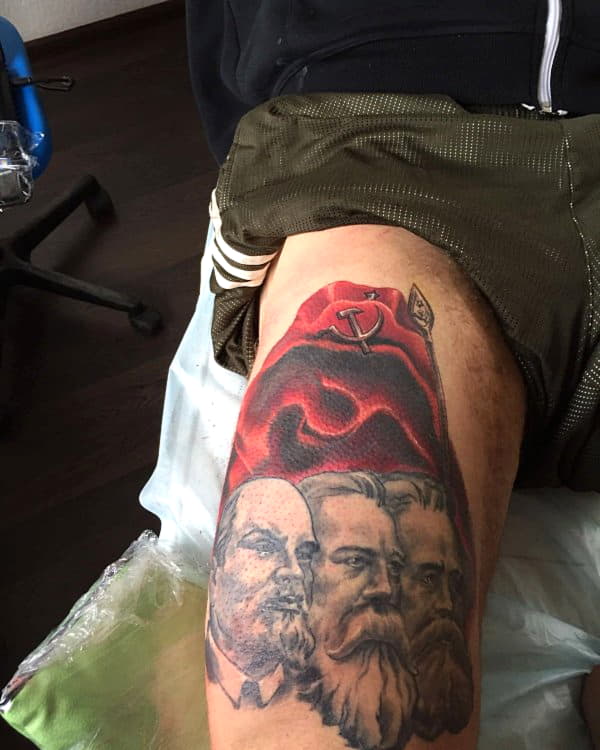

In addition, there is another opinion that tattoos of Lenin, Stalin and other prominent figures of the USSR were made by prisoners in order to gain loyalty from the regime. However, it is not known for certain whether such tattoos were effective in this sense.
Russian Freemasons
However, not everything is so unambiguous. According to some researchers, the emblem of the Soviet Union was a symbol of the occult movement of "free masons".
Writer Viktor Sparov in his work "A complete history of Freemasonry in one book" pointed out that the first credible evidence of the existence of a secret society in our country dates back to 1731, when the Grand Master of "all Russia" was appointed British Captain John Philips. Since then, many members of the domestic aristocracy, scientists and artists have joined the ranks of the Masons - some out of curiosity, and some for ideological reasons.
As is well known, the Leonardo da Vinci Society, of which E. I. Kamzolkin was a member, operated in Moscow from 1906 to 1911. According to the official version, the aim of this association was to assist young artists, assist in holding exhibitions, seminars and lectures on art. The community members did organize several cultural events.
However, the great Italian Leonardo da Vinci (1452-1519) was not only a fine painter. According to documents preserved in the archives of the Holy Inquisition, he was also the Grand Master of the secret organization "Priory of Zion". And his Russian followers, which included E. I. Kamzolkin, were also not limited to artistic research.
The creator of the "Hammer and Sickle" symbol, according to contemporaries, was well versed in the history and culture of Ancient Egypt, especially interested in Freemasons. The famous historian, Nikolai Albertovich Kuhn, author of the beloved by many book "Legends and Myths of Ancient Greece," called his friend, Eugene Ivanovich Kamzolkin, a true expert of ancient Egyptian mythology, based on the cult of the Sun god.
Different Styles
There are many variations on what the Stalin tattoo means, so it's no surprise that such a tattoo can be done in different styles. The most popular options are:
- old-school;
- new-school;
- realism;
- thrash polka;
- Dotwork.
Old-school and realism are exactly the styles in which tattoo masters in Soviet prisons performed their work. Their distinctive feature is the maximum resemblance to the original and the presence of elements such as quotations, ribbons and even roses.
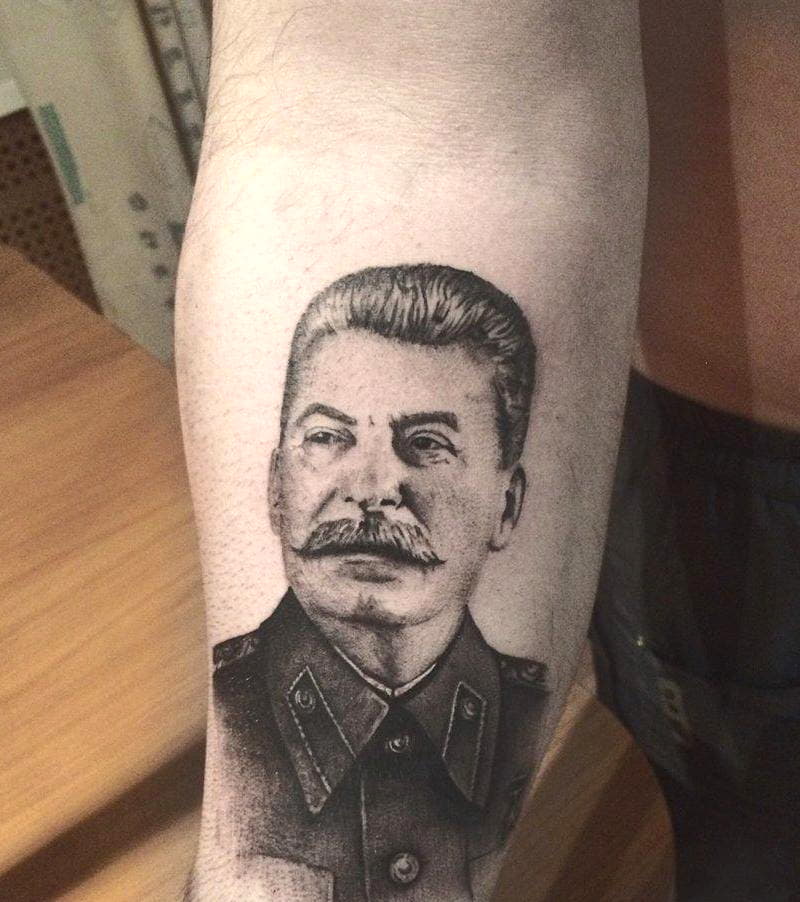

New-school and trash polka dots are suitable for those people who like to show their creativity. Here they can ask the master to portray Stalin in an unusual setting or in a comic situation. A characteristic feature of Thresh Polka is the predominance of red and black, as well as a certain gloominess of the subject.
The author of the symbol
Evgeny Ivanovich Kamzolkin (1885-1957) was a famous artist, photographer and decorator. He was born in a merchant family in the capital, graduated from the Moscow School of Painting, Sculpture and Architecture.
This man was constantly interested in the unknown. At the very beginning of the twentieth century, the young artist became fascinated by the innovative art of photography for that time. His works were presented in Turin at the international exhibition of 1907.
But, apart from a passion for photography, Eugene Kamzolkin had another passion in his life - Ancient Egypt with its mysterious mythology and history. It is no coincidence that he painted a lot of pictures devoted to this country. The most famous works of the artist are: "The Egyptian Woman", "Feast at the King of Assyria", "Into Battle", "In the Name of Ramses".
It was E. I. Kamzolkin in 1918 who offered the new Bolshevik power . symbol "Sickle and Hammer". This sign was first used in the festive May Day decorations of the Zamoskvoretsky district of the capital. There, in the local theater, after the October Revolution and the artist worked, creating scenery for performances.
In 1920, Evgeny Ivanovich decided to help the homeless. He moved to his grandfather's house, located in the town of Pushkino, taught drawing the pupils of the local children's colony.
In the framework of the historical project "Motherland", for the 100th anniversary of the symbol, the columnist of "Rossiyskaya Gazeta" Artem Lokalov published an article "Sickle and Hammer. Birch and Easter" in the Rossiyskaya Gazeta. In it he cited the words of Oleg Boiko, director of the local history museum of Pushkino: "For the first Soviet May Day there was a wish of the Mossovet - to depict the symbols of the new power. By that time there were different combinations - a scythe and a hammer, a plough and a hammer. But it was Kamzolkin who hit the spot.
And this artist has never taken part in the revolutionary events, and never joined the Communist Party. In General, his political views remain unknown to researchers. Although Evgeny Ivanovich has never been a recluse. As early as 1906, he joined the Leonardo da Vinci Society, and in 1923 he was one of the founders of the "Zhar-Tsvet" association of artists, which included such famous painters as K. S. Petrov-Vodkin, N. E. Lanceret, M. V. Dobuzhinsky and others.
Who else applied on the body portraits of Soviet leaders?
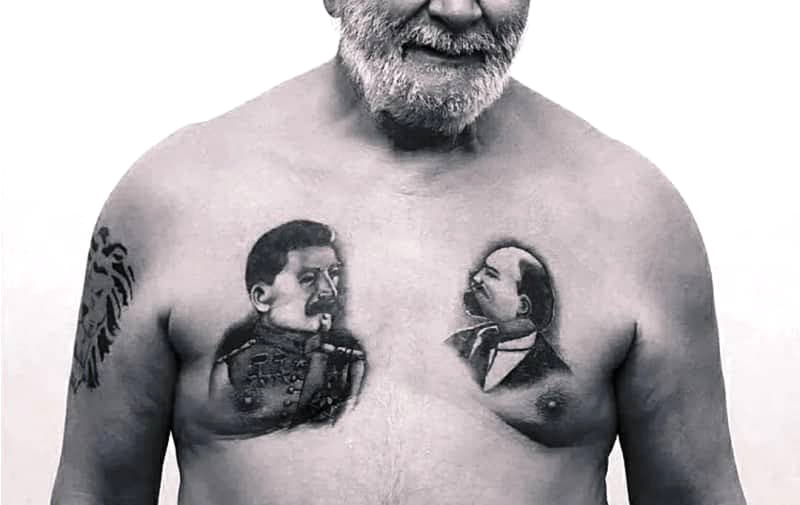

Often tattoos of Stalin or Lenin were painted by criminals on the run. The main idea was that if the prisoner was caught, he would tear off his shirt and show the Soviet leader on his chest or back. After that, law enforcement did not shoot the fugitive, but beat him severely. The main thing was to stay alive.
The second option was for the escaped prisoner to run into a "green" guard. If an inexperienced jailer saw a criminal with images of Soviet leaders, he was lost. Seizing the moment, the prisoner simply escaped.
Prison officials could not stop criminals from tattooing images of Stalin or Lenin. Often prisoners would apply them secretly or get into the zone at all with these portraits on their backs or chests.
Appearance
The coat of arms in its final version was the official sign of the state from 1956 to 1991. Its appearance is familiar to every modern Russian - in the center there is a globe on a scarlet cloth, under which the solar disk rises. This composition is surrounded by sheaves of ears twined with scarlet ribbons. In the foreground on a piece of ribbon is the text in Russian, "Proletarians of all countries, unite!
The spikes of ripe wheat around the lower edge are wrapped with similar ribbons, on which the same inscription is written in gold in the languages of the countries participating in the Union. At the top, the design is topped with a five-beam star with a yellow border.
Shoot!
Photo © Wikimedia Commons
Later, in the 1930s and 1950s, this life-saving move was adopted by Gulag prisoners. Many thieves tattooed Stalin and Lenin on their chests to avoid execution - the execution teams cowardly shot the images of the leaders and the recidivists lived.
If a convict stabbed himself with Stalin's profile on his chest, it meant that he was ready to "go to the green prosecutor," in other words, to go on the run. And when the search team caught up with him, he ripped his shirt across his chest - shoot! Of course, no one would shoot at the profile of the leader and teacher, the convict would be beaten to death, but left alive. Some of them stabbed a whole iconostasis on their chests - Marx, Engels, Lenin, but in the center there had to be Stalin.
Photo © Wikimedia Commons
Note that portraits of Lenin and Stalin on the chest did not always save prisoners. True, only one such case is officially recorded. Warden Sviridov in January 1938 witnessed such a scene and ordered his subordinates to use a rifle bayonet to cut the skin of a prisoner with the image of the leaders on his chest before he was shot.
Hammer and sickle
If we talk about ancient Egyptian mythology, which E. I. Kamzolkin was interested in, something similar to the traditional hammer and sickle can often be seen in the hands of the god Seth. And he represented destruction and chaos, sandstorms and death.
Many researchers, ideologically distant from communism and Freemasonry, often consider the symbol of the hammer and sickle a sign of the destruction of the world and the victory of the forces of evil. They associate the hammer with the Scandinavian god Thor and the Slavic thunderer Svarog. In addition, in ancient Indian and Chinese mythologies, this working tool means the triumph of destructive forces over creative ones. It is noteworthy that the Hindu goddess Kali, like the Slavic Mara, often holds a sickle in her left hand on her images.
However, not all experts are inclined to interpret this sign negatively. For example, the author of the book "In the power of symbols" Konstantin Klimovich does not see anything bad in it.
"The sign that is familiar to our eyes today is often referred to as a symbol of destruction. It is assumed that in the recent past the enemies of the Russian land have put in the SERP and MILTON some secret meaning for the implementation of their nefarious plans and designs. But we know that it is a symbol of creation and labor. That's how we accepted it," the writer noted.
New additions
The countries that appreciated the advantages of the new union state were added, and accordingly strips of ribbons with texts in the native languages of the participating republics were added. From 1937 to 1946 there were eleven turns on the sheaves. In the autumn of 1940 it was suggested to increase the number of turns on the coat of arms, because new countries were added to the USSR. In the spring of 1941 an updated version was proposed, but with the beginning of the Great Patriotic War, all refinements were suspended. The updated draft was approved only in June 1946, when the war with Nazi Germany was won.
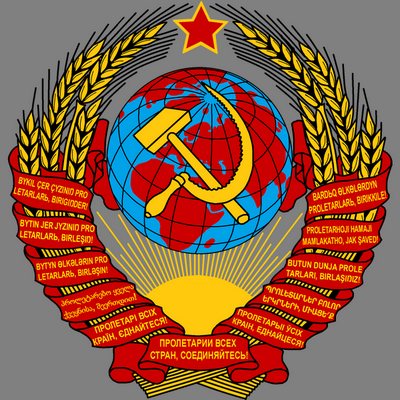

1937—1946
In the new version, the main thesis was written on the elements of the ribbons in sixteen languages - Moldovan, Latvian, Finnish, Lithuanian and Estonian were added. In this version, the symbol was in demand until 1956.
In 1956, the strip with the inscription in Finnish disappeared from it. The Commission decided that the Karelian-Finnish SSR, which had achieved independence as part of the RSFSR, should not be present on the common sign. In 1958 the content of the phrase in the language of Belarus was changed. Revisions to the draft sketches were proposed by designers I.S. Klykov, S.A. Pomansky, S.A. Novsky and their colleagues.
Tattoo coat of arms: meaning, photo tattoo, sketches
Tattoo with the image of a coat of arms means belonging to a certain circle, superiority, loyalty, deference to the authorities and the state, an indication of their goals, life principles or strong qualities of character, power.
The meaning of the coat of arms tattoo
Since ancient times, any nation, community or group of people associated with certain interests had its own sign, which previously looked like a religious symbol or totem. Since the Middle Ages, coats of arms began to appear in England, which were worn by knights and passed on to their heirs. A little later coats of arms began to mark cities and countries, with shields, helmets, mantles or inscriptions depicted mainly on them.
Tattoo with a coat of arms choose for themselves mainly men, whether it is the symbolism of sports clubs, the state, the family or any closed society. The meaning of such a tattoo, unlike other images, is strictly individual and depends on the nature of its owner, his life views, interests and experiences.
If the person has the national emblem or a sports team on his body, he wants to show his loyalty to them. By the way, applying the emblem of the state, for example, in Sweden, on the body is prohibited to all except members of the royal family or civil servants. But the flag of Sweden may well choose to be a tattoo and the average citizen.
In our state a tattoo with the Russian coat of arms speaks of devotion to one's country. It is well known that the symbolism of the country has often changed depending on the specific historical period. Today it is a double-headed eagle against a red heraldic shield. Above the bird's head there are three crowns of Peter the Great, representing the legislative, executive and judicial branches of power, in his paws - a scepter and orb, and on the body - a rider with a spear, killing a snake - St. George the Victorious.
The most popular components of the coat of arms are the crown and the eagle, which have different meanings based on the overall composition of the image. For example, since ancient times, the eagle symbolized the sun, power, eternal life, belonging to the royal family. In ancient Rome the eagle was the symbol of victory, and in Christian culture it symbolized a strong spirit and strong faith. Today the eagle symbolizes freedom, courage, bravery, power and majesty. The drawing of the eagle on the coat of arms characterizes a strong person, not limiting himself to search for simple solutions, a leader with independent views.
The crown also has multiple meanings. Its image in the coat of arms may indicate the presence of royal or aristocratic blood, material well-being, authority. The crown is often combined in a tattoo with other elements than can emphasize superiority over them.
In general, we can conclude that the emblem tattoo indicates the desire to show their belonging to a particular group of people or the state, to talk about their principles and goals in life or to tell about the strength of character.
Did you like the article? Tell your friends: Please rate the article, it is very important for us:
Voted for by 2 people.Average rating: 5 out of 5.
Historical flags of Soviet Union
The first red flag appeared on the barricades of the Paris Commune in 1871. In Russia, the red banner became the symbol of the 1905 and 1917 revolutions. From 1918 to 1923, the red banner was declared the official symbol of the Russian Federal Socialist Republic.
December 29, 1922 was the date of formation of the Union of Soviet Socialist Republics, which included four republics: Russian, Ukrainian, Byelorussian and Transcaucasian. The Union Treaty stipulated that the USSR had its own flag, emblem and state seal. The first version of the state symbol, where the coat of arms was on a red background, was invented by K. I. Dunin-Borkovsky.
A detailed description of the state flag is outlined in the Resolution of the Presidium of the CEC of the USSR of April 8, 1924. The appearance and form of the state symbol remained unchanged after the adoption of the USSR Constitution in 1936. By the Decree of the Presidium of the Supreme Soviet of the USSR of August 9, 1955, adjustments were made to the image of the sickle, hammer and star. The Constitution, adopted in 1977, made no changes to the flag.
In August 1980 a new "Regulation on the State Flag" was adopted. The images of the sickle, hammer and star became one-sided.
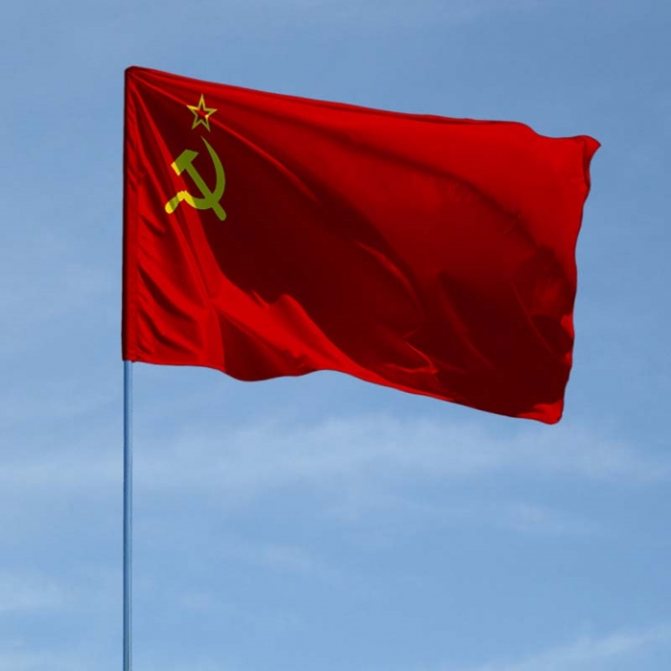

The secret meaning of the Russian state symbols was revealed by the country's Chief Heraldmaker
The meeting took place in Vilinbakhov's office at the Winter Palace, with a view of the Neva and Peter and Paul Fortress.
- Georgy Vadimovich, a year ago the composition and regulations of the Heraldic Council under the President of the Russian Federation were approved. But the service itself is over a quarter of a century old. Could you tell us how you got started?
- The Heraldic Service of Russia was created in 1992 by decree of the government. Unlike other federal agencies that were created in Russia after 1991, ours was, as Peter the Great said, "a matter of new founding. There was no such service in Soviet times. Moreover, the tasks which our service faced were also different from those which faced the Department of the Heraldry of the Governing Senate during the Imperial period. That first deals with issues related to the nobility, the maintenance of the General Armorial of the Russian Empire, which were listed coats of arms titled families.
The language of signs
- And who was in charge of heraldry in the USSR?
- No one. If necessary, a commission was formed by the Supreme Soviet, and a competition was announced. Everything was quite spontaneous. Besides, in the Soviet period there was no territorial heraldry - symbols of regions and cities. So in 1992 we had to create a lot of things anew, and this discipline began to be seen not only as some kind of applied thing related to the creation and use of coats of arms; it came to be understood that this is a real language of signs!
- So it's not only coats of arms?
- Heraldry in a broader sense is not only coats of arms and not only a phenomenon of European civilization, as it used to be considered. Yes, it took shape as a phenomenon in the Middle Ages, during the Crusades and the knights' tournaments, in connection with the need to mark the knights. But in fact, like any other language, it has its own history of development. Heraldry can have its national specifics. And probably the fundamental principle for its existence is the understanding of the social function that coats of arms, flags and other symbols perform, whether we are talking about marking an individual or an entire social group. It becomes clear that the heraldic signs are both Indian totems and Turkic tangs. That is, those signs which help to distinguish one clan from another, one tribe from another.
- The hammer and sickle on the Soviet flag, the star on the emblem of the USSR are also heraldic signs?
- Yes. But one must distinguish: every heraldic sign is an emblem, but not every emblem is a heraldic sign. Only if an emblem serves the function of designating a social group, it is a heraldic sign. For example, the sword as an order sign in Sweden is a heraldic sign, and the sword "out of the mouth" is an emblem, connected with the revelations of John the Evangelist, where a fiery sword is mentioned.
What the colors of the Russian flag mean
- When did Russia decide to bring back the old Russian symbols - the tricolor and the two-headed eagle?
- In 1990, there was a corresponding decision of the government of the Russian Soviet Federative Socialist Republic to create a commission to change the symbols of the RSFSR. This commission, which consisted of deputies and ministers, in December 1990 instructed a group of specialists to prepare proposals. And then the first idea was expressed that it was necessary to return to the historical foundations - to return the Russian flag and coat of arms.
- Why did you choose the flag of Peter the Great times?
- The white, blue and red flag first appeared in the reign of Alexei Mikhailovich. It was sewn for the first warship "Eagle". Another thing is that we do not know for sure how exactly the drawing looked like. We only found an instruction in the archive: to issue cloth of white, red and blue colors for the ship "Eagle".
- That is, they arranged them in the order we see now, later?
- We proceed from the actual data. The flag of the Russian Federation was modeled on the "flag of the tsar of Moscow," under which Peter Alexeyevich sailed in Arkhangelsk and which is kept in the Naval Museum. For a while the white-blue-red flag was introduced as a insignia for the entire Russian Navy. After a while, the flag of St. Andrew was introduced for the military fleet, and the tricolor remained for the civilian, merchant fleet.
- Is there any scientific research on how the colors of the national flag affect the psychology of citizens?
- I have not heard of such a study. Is it strange that you don't ask the question of what the colors symbolize?
- I have heard that white symbolizes purity, blue symbolizes loyalty to duty, red symbolizes courage and sacrifice...
- Well, I'll tell you, these colors don't mean anything! Except that, in this order, they represent the country of Russia.
- How can it be, without symbolism it is somehow boring.
- All attempts to interpret the coloring of our flag are heraldic mythology. Some believe that the tricolor is a symbol of the Trinity or a symbol of the three elements, others have a popular version that it stands for three Slavic countries: Russia, Belarus and Ukraine... But there is nothing of the kind.
Heraldry is an absolutely functional thing. What are the heraldic signs used for first of all? The main function is to distinguish between two ships so that when you see them, you can say: this one is Russian, and this one is English. So that when you see two embassy buildings in the distance you can tell from the flag: this is the French embassy and this is the Russian embassy.
It is quite another matter, if the meaning was initially laid down and fixed in some historical document. But since we have no such explanation, we cannot interpret the heraldic sign in our own way.
Where does the double-headed eagle look like
- Tell us, how quickly did you come to the decision to adopt the double-headed eagle as your coat of arms?
- The debates were long. Members of the special commission were worried that the people, who were on the verge of electing their first president, would not understand them. They suggested that the emblem of the RSFSR should be kept, but that the political emblems, the hammer and sickle, should be removed from the emblem. But without them, the emblem would be empty. There were exotic proposals to make the swallow or bear the emblem of Russia... Other projects were helpless from the point of view of heraldic grammar. Many of the drafts were destroyed in the White House fire in 1993.
As a result, it was decided to pay tribute to the country's history and return the historical symbols to it. In the end, we opted for the golden double-headed eagle on a red background and the white, blue and red flag.
- You mentioned heraldic grammar. Is there really a serious set of rules?
- There certainly is. There are specific sets of colors, metals, and their combinations. There are rules for the placement of figures, rules concerning the meaning of certain elements.
- Where do the metals come from in a graphic depiction?
- The word "metals" in heraldry refers to the colors gold and silver. There are also "finials" - red, black, green and blue colors. And there are those that cannot be used in a coat of arms, these are all "impure" colors - halftones or combinations thereof. There are also natural colors. For example, the bear can be either heraldic colors (gold or silver), or natural.
- The meaning of the eagle on the coat of arms was stipulated so that the descendants do not break their heads, coming up with different interpretations?
- No, we did not attach any meaning to the eagle. And the interpretation that one of its heads looks to the west and the other to the east is just another poetic image, which, in particular, was cited by Academician Dmitry Sergeevich Likhachev. There is no interpretation of the eagle in official documents. It is simply a symbol of our state since the 15th century. Even in 1918, the new Soviet authorities, before the approval of new symbols, used the old coat of arms. There is a document signed by Vladimir Ilyich Lenin, which bears a seal with a double-headed eagle.
When there is such a centuries-old history of heraldic sign, to change it for the sake of swallows or bears is not reasonable. The double-headed eagle was enshrined as the emblem of our country by the decree of President Boris Nikolayevich Yeltsin on November 30, 1993.
The flag for the arrival of guests
- You became head of the Heraldic Service in 1992, and Chief Heraldry Master under the Russian President in 1994. What was the reason for approving a new regulation for the service in 2019?
- It's simple - it was necessary to bring the previous decrees in line with the new Federal Law on State Symbols. Without it, some tried to challenge it, saying it was being used illegally.
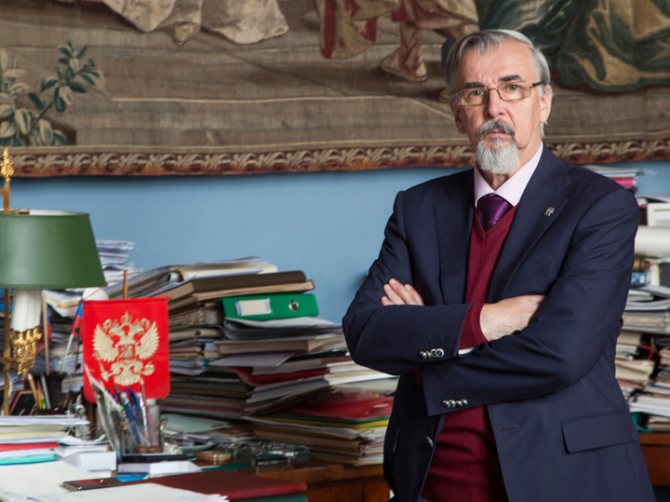

Georgy Vilinbakhov
- There are lines in the statute of the Heraldic Service about the popularization of symbols. How do you understand it?
- It should be understood as the dissemination of reliable information about them.
- I foresee the question of the man in the street: what else don't we know about them?
- We know more or less now. But back in the '90s, I had to hang the flag over one of the police stations in Leningrad with my own hands, because the flag was hanging upside down. It's important that people remember the order of the colors so that there is no historically unfounded speculation. For example, there was talk that our flag was a Dutch flag in which the colors had simply been changed. How can we talk about this, when we know exactly about the order about the flag of Alexei Mikhailovich...
- What facts of heraldic ignorance do you face today?
- Now and then myths and inaccurate formulations appear. For example, the fact that our flag repeats the national flag of 19th century Russia...
- So it does...
- Here you are caught in ignorance of heraldic history. In the nineteenth century there was no such thing as the Russian state flag. The term "state flag" did not appear until the early 20th century, which corresponded to the concept of "national flag" that existed in a number of countries.
Some countries have a pair: a "national flag" that all residents can use, and a "national flag" that can be displayed only at government offices or during official events. This is the way it is arranged in Finland, for example.
- We also have a flag without a coat of arms and a flag with a coat of arms...
- Yes, but the name and the rules of their use are different. The flag without a coat of arms, i.e. the tricolor, is considered the state flag, and all citizens can use it; it is also raised when our athletes win in the official sports games, etc. As for the flag with coat of arms - this is the President's standard, which can only be used in his office.
And our task as members of the Council is to periodically remind Russian officials that they should not install the presidential standard in their offices. This is a direct violation of the presidential decree on symbols of power.
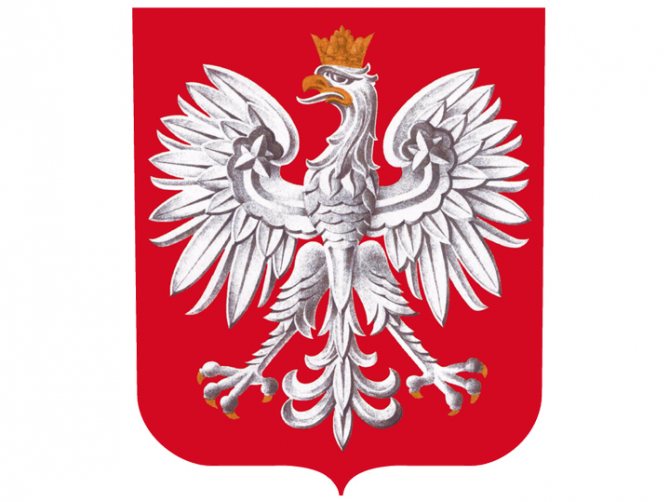

The Polish coat of arms. Birds are one of the most popular heraldic symbols in various countries.
- Our people, after all, have not caught on to the American tradition of displaying the national flag on private property. Why do you think that is?
- It was not inherent in our culture from the very beginning. Back in Soviet times, we were accustomed to the fact that the use of flags was strictly regulated. After the celebration, all the flags were hidden in the housing office until the next holiday.
In the beginning, our law enforcement bodies by inertia tried to fine those who raised the flag over the house, referring to the fact that the Regulation on the flag allows using it only on holidays. We had to explain to them that in this case we are not talking about public holidays, there is no definition in the Regulation of what a holiday is. Everyone can have their own holiday. For example, about the fact that my grandson brought a "five"... Now people are not forbidden to hang flags on their houses.
- But still there aren't as many people like that in the West.
- And in the West, too, it's different everywhere. In private homes in Scandinavia, they love to raise flags. You drive down the street there - almost every house has a flagpole. The flag is raised on birthdays, or just when guests come. There is no such thing in Germany or France. So let us also live our lives the way we feel most comfortable and natural, not the way they live in Europe and America.
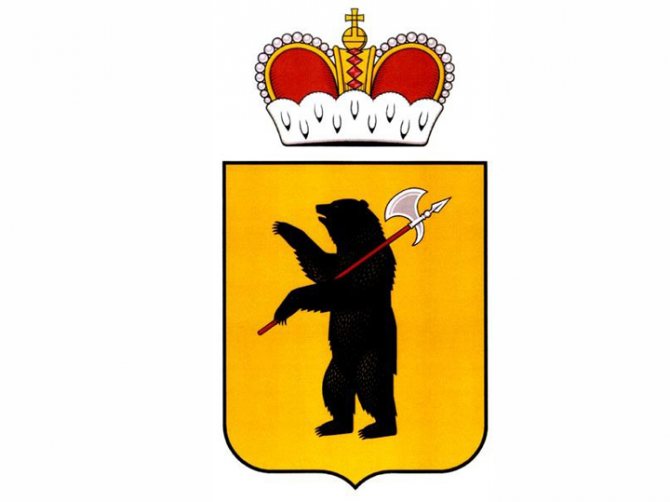

Approximately the same bear as on the coat of arms of Yaroslavl was originally proposed to be depicted on the coat of arms of the Russian Federation.
A "cudgel" for the illiterate
- Is the appearance of heraldic symbols in regions and cities a tribute to old traditions, which existed in tsarist Russia?
- Yes, it is a revival of an old tradition. In accordance with the Constitution and the broader powers of the subjects of the Federation, many regions got their own coats of arms. Regional flags appeared later. After 1996 when subjects received additional powers to conduct independent foreign economic activity they became necessary for negotiations. For example, the mayor of Helsinki met with the mayor of St. Petersburg. The mayor of Helsinki puts a flag of Helsinki on the table, but ours has nothing but the national flag. But the state flag in this case is inappropriate, overstating one's status can be perceived as disrespect for the partner... That's why regional and city flags began to be created.
- Do you keep track of their appearance?
- Our Council has an advisory and expert function. If a city decides to draw its own coat of arms, they submit them to us for approval. We review it in terms of literacy, identify possible plagiarism, and then recommend it for use or not.
- But what if your expert functions are neglected?
- In this case we have our own "cudgel" - the state heraldic register. If we do not approve a coat of arms, it would not be included in the state register, and therefore would not be considered an official symbol.
- What coats of arms have you had to "unfurl"?
- Those in which we see a violation of heraldic grammar, for example, where the enamel is superimposed on the enamel or metal on metal. It is illiterate to place the green bear on a red field - it can be either yellow or white. The same golden eagle cannot be depicted on a silver field.
Territorial coats of arms began to be created in the 18th century. Local peculiarities and traditions were taken into account. If the town had a soap manufacture, pieces of soap could be depicted on the coat of arms. It happened that the coat of arms reflected a verbal symbol of the city, for example, the eagle in the coat of arms of Eagle. When modern mayors come to us, we explain that if the city has an old, pre-revolutionary symbol, the priority is better to leave it. The new symbol of the city must be such that it cannot be confused with another city. For example, they want to depict a pinion on the coat of arms, reflecting the developed industry. We ask, "Isn't there any industry in the next town?" Sometimes they suggest things that are a priority today, but may become irrelevant tomorrow. We ask: "Well, find something more interesting, emphasizing your peculiarity.
- Is plagiarism common in heraldry?
- It used to occur more often. Today, it can probably be found only in the middle of nowhere, where administrations have no heraldic committees of their own.
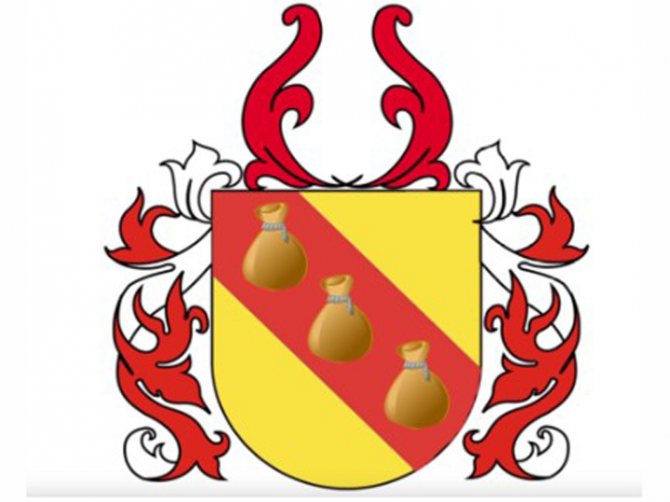

In the center of the coat of arms of the Van der Burset family (Belgium) there are three purses as a symbol of the world's first stock exchange, organized near their house.
Large Soviet coat of arms on the State Duma building
- Ruby stars adorn the Kremlin. Can they be considered heraldry today or are they just symbols whose heraldic meaning has become obsolete?
- The red star was a heraldic element of the Soviet Union. As such it was placed on the towers of the Kremlin. The same applies to some honorary names and corresponding symbols in the army. For example, the Kantemirovskaya or Tamanskaya divisions became Guards divisions during the Great Patriotic War. And if they have preserved symbols associated with that time, it is certainly better to leave them, which is what we are doing.
- Are there any other sites that still have their old symbols?
- By the time our Service was incorporated, the question of the coloring of the border posts had become acute. Russia received new borders after the collapse of the Soviet Union, and some suggested painting the posts in the colors of the new flag. But we decided it would be better to keep the red and green colors of the border markers. These are the traditional colors of the border service from the days of Tsarist Russia and they were not changed under Soviet rule, so we decided to keep the historic colors.
In the '90s, when the change of state system started, there were many voices calling to knock down and destroy all the symbols associated with the Soviet times. But there is no such thing as symbolism. If it is an element of architectural decoration, in my opinion, it should not be destroyed. In addition to the stars on the towers of the Kremlin, a large emblem of the USSR was also recognized as such an architectural decoration, mounted on the facade of the former Gosplan building in Okhotny Ryad (now home to the Russian State Duma). I spoke in its defense, because it is unacceptable to resemble the Bolsheviks, who indiscriminately knocked down the tsarist eagles everywhere. We should value our own history, especially if the symbols of the bygone era are works of art. When you go to the Elysee Palace in Paris, you can see symbols of Napoleon's and Bourbon's times in the decor of different living rooms. In London, the monument to the revolutionary Cromwell and the monument to Charles I, who was beheaded by Cromwell, are preserved.
And this is all, oddly enough, also the popularization of heraldry.
In addition, today all the law enforcement agencies have their own heraldic services or councils, with whom we work and discuss issues of military heraldry. This is part of our culture.
- Speaking of the military, to be more precise, the heraldic insignia with which the chosen ones are awarded - orders and medals. What order in modern Russia is considered the most deserved?
- The Order of St. Andrew the Apostle. It is on a par with the Order for Merit to the Fatherland, First Class.
- How many of our citizens are holders of the Order of Saint Andrew?
- I know three holders of this order - Dmitry Likhachev, Daniil Granin and Mikhail Kalashnikov.
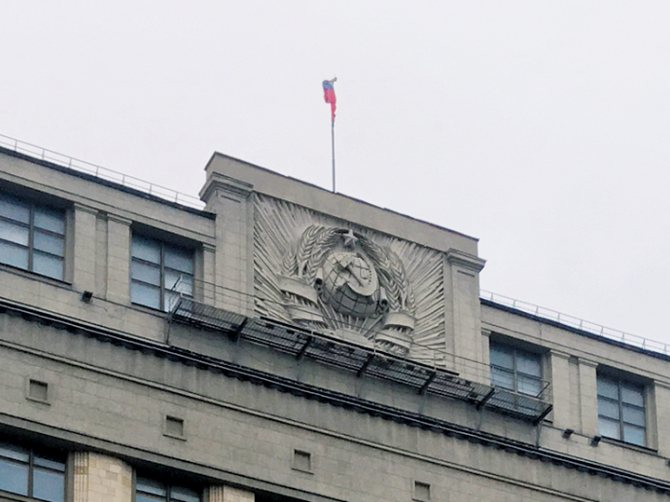

The coat of arms of the Soviet Union was preserved on the building of the State Duma as a tribute to art. Photo: ru.wikipedia.org
Trademarks and personal emblems
- Georgy Vadimovich, trademarks and logos of all sorts of companies are heraldry?
- That's a good question. It all depends on whether they perform a social function. If they only mark products, they are a logo or an emblem, nothing more. But if a company's sign is at the same time the sign of a group of all workers, then it can be considered heraldic. Example: in our country, the words "Mercedes," "Audi," or "Toyota" refer only to companies. But if you go to Japan, you will meet people who wear Toyota badges, indicating that they belong to a special social group of workers.
- It is believed that for the prestige of the company it is better to keep the same logo as long as possible. In this regard, the motives for changing the trademark of a major Russian bank are unclear. What could this be due to and can its logo be considered heraldic?
- As for this bank... I do not understand why they had to change the sign and the name. If we talk about heraldry - and it should be recognizable - the color scheme the bank uses, in particular the white and green uniform of its employees is considered as such.
- What advice would you give to someone who decided to create a family coat of arms for their family?
- Anyone can have a family coat of arms, families are welcome to create one. Only before ordering a designer to design, think about where you will use your coat of arms. Hang it on the fridge, on the car door? It is necessary to understand why you need it.
In ancient times, members of noble families created coats of arms as distinguishing signs. Everyone knew that the palace with the coat of arms of Sheremetev belonged to a famous count, and the estate with the coat of arms of Yusupov - to a famous prince. The coat of arms on the carriages of those noble lords helped the livery attendant to quickly determine who had arrived.
- In modern Russia, the traffic policemen quickly see who has arrived by the "cool" license plate on the car...
- By the way, that's a good point. Yes, the special license plates, as well as the special location of blinkers on the roofs of the cars very eloquently helped to understand the level of the boss as a passenger. According to this sign, they can be attributed to some extent to heraldic signs.
- If a person decides to create his own coat of arms, will you put it in some registry?
- No. Even if a person is a count or a prince, we will not include it either. We do not have a class state, since Soviet times all estates were abolished and, accordingly, all pre-existing class coats of arms have also lost their social significance. Such coats of arms are important for family history.
- But we know many examples where people are looking for their roots, returning to their titles of nobility...
- They do this solely to pay tribute to the history of their family, nothing more.
And this is what we help those who come to us for help. There are historical archives, a pre-revolutionary armorial of noble families. There is a lot of reference literature.
But the memory of the past of their families, many people have managed to keep their own.
In my family, by the way, the memory of our ancient noble family has been preserved. I inherited my grandfather's ring with the family coat of arms.
There was another category of citizens who, for various reasons, tried to forget about their high-society past. In the case of a search and finding relevant documents, they would have faced serious reprisals. In such families one can see strange family photographs in which some of the men have only their faces cut out and glued to a common photo. It is very likely that these men once served in the tsarist army and their relatives simply cut out images of their uniforms.
- Are there any cases of forgeries of titles of nobility today?
- There are illiterate people who draw princely crowns, shield-holders, orders to their coat of arms-models, having in fact nothing to do with either the noble family or the heroic past of the country. Meanwhile, even the common family coat of arms of the Sheremetevs did not have the Order of St. Andrew and the Cross of Malta. They could only be depicted on the personal coat of arms of their owner, Boris Petrovich, who was in Malta.
- Is your coat of arms listed in the Armorial?
- No. My ancestors came to Russia from Thuringia (East Germany. - Aut.) under Ivan the Terrible. Most likely came with a title and coat of arms. Such people were accepted without asking for proof of belonging to a noble family. These proofs were necessary then, years later, at entering of a patrimonial coat of arms in the Armorial. My ancestors did not do this and lived with unapproved coat of arms. By the way, it did not influence their career in any way.
Taking into consideration the contribution of Doctor of History Georgy Vilinbakhov to the revival of Russian heraldry and the preservation of historical memory, he is justly considered a descendant of an ancient noble family, serving his country faithfully.
Sentenced to execution
A new batch of death row inmates was brought to the prison on "black funnels. Those sentenced to execution were brought to the basement, where they were placed along the wall. They were told to take off their shirts. Suddenly the Chekist noticed Stalin's face on the chest of a death convict. He tried to erase it, but he failed. The tattoo was firmly embedded in the skin.
The leader's face threw the guards into a stupor. If you shoot a prisoner, you'll hit Stalin. The suicide bomber was told to turn his back. It did not help - there was a portrait of Vladimir Lenin on his back. After a long scolding the guards led the prisoner out of the basement.
Alternative Flags
The USSR flag was to be present on the stern of sea and river ships, as well as to be depicted on aircrafts making international voyages. On navy ships, it was mandatory to raise the state symbol before battle or at the sight of the enemy.
After the collapse of the state, its symbols remained in demand. Decorators create and offer for sale their versions of the former state flag. So, on the Internet offer cloths with the coats of arms of the 15 republics, placed around the emblem of the USSR, or a combination of sickle, hammer, star and emblem of the USSR on one field.
History of creation
The first draft of the sign approved in July 1923 the Central Executive Committee, the highest authority of the young state (the responsible secretary - A.S. Enukidze).
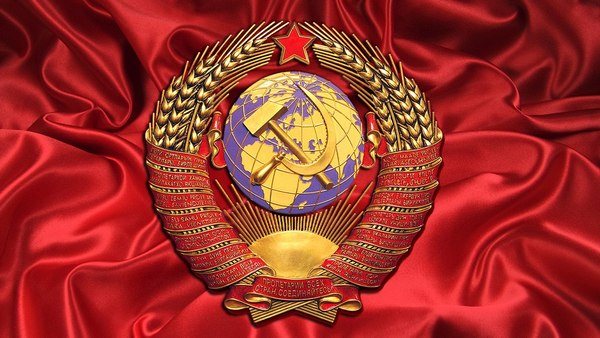

The main parts of the drawing were taken from the emblem of the RSFSR, approved by Vladimir Ilyich Lenin himself. The sketch, proposed by artists V.P. Korzun and V.N. Adrianov, was finalized by I.I. Dubasov, who came up with sketches of new money for the state. The famous scarlet star at the top of the coat of arms, an idea of A.S. Enukidze, was approved unanimously.
In July 1923 the appearance of the required status symbol was documented in an article of the basic law of the state.
The coat of arms had three turns of scarlet ribbon around the ears on each side. Six turns of the strip had texts in Ukrainian, Georgian, Russian, Belarusian, Turkic-Tatar, and Armenian. A few years later a spiral was added with the text in Turkic in Latin, and the inscription in Russian came to the foreground at the bottom.
The coat of arms on the postage stamp of 1926
There is an opinion that the creators were inspired by the coat of arms of America (the ribbons) and the German coat of arms (scarlet and hammer shown on the coins).
